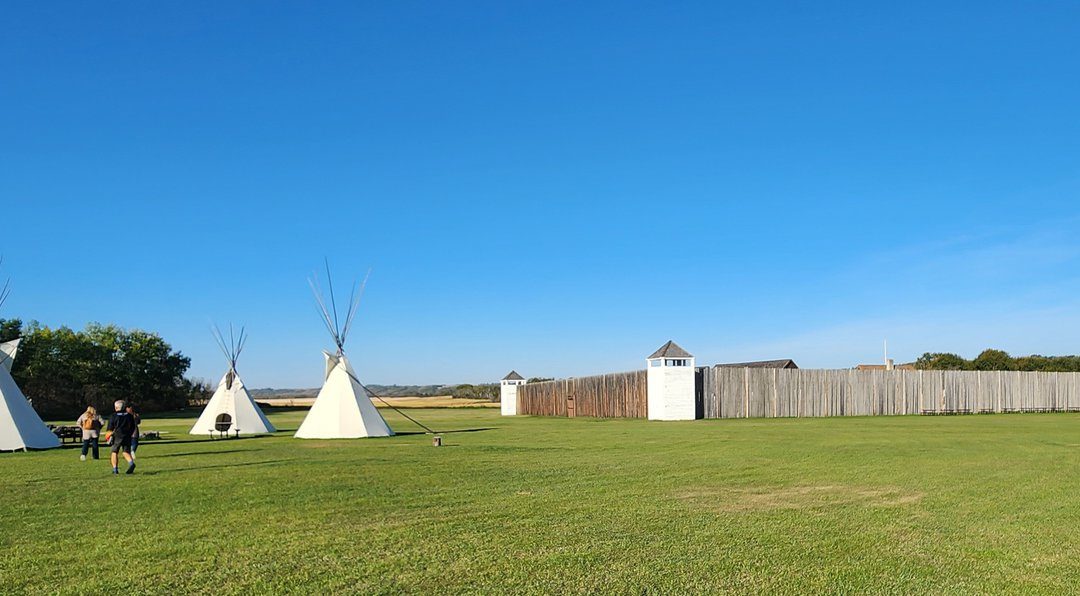Photo: Fort Carlton, Saskatchewan / Carol Baldwin, LJI
By Carol Baldwin
Local Journalism Initiative Reporter
Wakaw Recorder
Treaty Talks are a storytelling and learning experience hosted at Fort Carlton Provincial Park by Pêmiska Tourism. Whether indoors or gathered under the open sky, these sessions gather people together around the fire to sip on warm refreshments like Juniper tea and hear knowledge keepers share Treaty 6 stories that connect past, present, and future. A shared understanding is important because, without understanding, there is no common ground. For over 120 years, Canadians were denied the truth about Indigenous peoples, their histories, and their lived experiences. Indigenous tourism, like Pêmiska Tourism operated by Beardy’s and Okemasis’ Cree Nation, offers a chance to engage meaningfully in reconciliation while supporting the economic strength of First Nations, Inuit, and Métis communities.
Pêmiska is a Cree word. In English, it means “come and find it.” The name is an invitation from the people of Beardy’s and Okemasis’ Cree Nation. The “it” in “come and find it” can be anything from culture, history, truth, or adventure. (https://pemiska.ca/)
“It goes back to the intent of what the Treaty was,” Roy Petit said. “To work together and share this land, and that it would benefit everybody.”
Petit is a Lodge keeper, Pipe Carrier, and a Knowledge keeper. He met with members of the Prairie Rivers Reconciliation Circle on September 24th for a Treaty Talk. Chief Beardy and Chief Okemasis settled in the area between the floodplains of two Saskatchewan Rivers close to where Fort Carlton was located. Thus, the Willow Cree name was born. Eventually, the two chiefs agreed to join their bands together with a single handshake. The Beardy’s & Okemasis Cree Nation (BOCN) sits between Duck Lake and Fort Carlton, one of the first locations where the signing of Treaty 6 was held.
When he was elected to the BOCN Band Council, Petit said he knew he needed to understand the Treaties better and set out to learn. It has only been in recent years that people, Indigenous and non-Indigenous, began to try to learn more about the Treaties and how things went so wrong. Before 2000, most people only understood that treaties were signed many years ago, but few recognized their ongoing relevance. A treaty is a legal document, not just a piece of paper exchanged between two sovereign nations. However, they are more than just legal documents. At their core, treaties are about living together with respect and partnership. Treaties embody stories of forgiveness, peace, and harmony, reflecting the spirit of reconciliation and serving as both a symbol and a practical tool for healing and co-existence. By the Crown signing the Treaties with First Nations, it acknowledged their sovereignty. Treaties are stronger than the paper they were written on. Treaty agreements are not just for the history books; they are not old news. In the international world, the Treaty is recognized as legally binding to the parties who entered into it.
First Nations concluded the signing of Treaty 6 by sacred pipe ceremonies and the exchange of important symbols, like the treaty medal. The pipe ceremony connected the Treaty promises to the Creator. The sharing of the pipe between two parties forms a united bond; promises made through the pipe cannot be undone; they are binding and forever. Therefore, the sealing of these Treaties through traditional Indigenous protocols invited the Creator to witness the promises made between the two sovereign nations and thereby ensure that those promises would not and could not be broken. Treaty medals were given out by government representatives at each numbered treaty and included images that reinforced these points; a European settler and a First Nations representative shaking hands over a buried hatchet symbolized peace. A rising sun over an indigenous encampment showed the people they would be able to keep their way of life. The growing grass, the sun, and the rivers on the medal meant that the promises in them would last as long as the sun shines, the grass grows, and rivers flow.
Poundmaker is reported to have said during the negotiations, ‘You can’t take the land and break it like pemmican and give it back to us in little pieces.’ Unfortunately, that is exactly what the government did with the Indian Act, which was signed and sealed by Parliament, months before the Treaties were signed, in April 1876. The Government, in its colonialist mindset, did not respect Indigenous ways, even when it came to Treaty-making and entered into Treaty negotiations with First Nations with the knowledge that what they were promising was an illusion, and there was no intent to share the land. The buffalo were all but gone, and the Willow Cree people and all other Indigenous peoples were living in famine. The Chiefs, wanting to take care of their people, signed the Treaty with an optimistic hope for the future.
Reconciliation is about acknowledging the Treaty and moving towards getting present-day provincial and federal governments to accept and acknowledge that the Treaties are a partnership, a sharing of the land and its riches, not as hand-outs, but, to use a business term, as shareholders’ dividends.
As non-Indigenous people, we can do our part in reconciliation by acknowledging what happened, talking about it, opening our minds to seeing things differently, opening our ears to hear things differently, and making personal changes to how we live so that others can see and follow. We cannot, as a group, go out and “fix” things; we cannot change other people’s minds, but they can see the change in us and decide to make their own changes.
We are all Treaty people with Treaty responsibilities to live in good relation. The Creator put us all here together, so we all have to figure out how to share and go forward.
